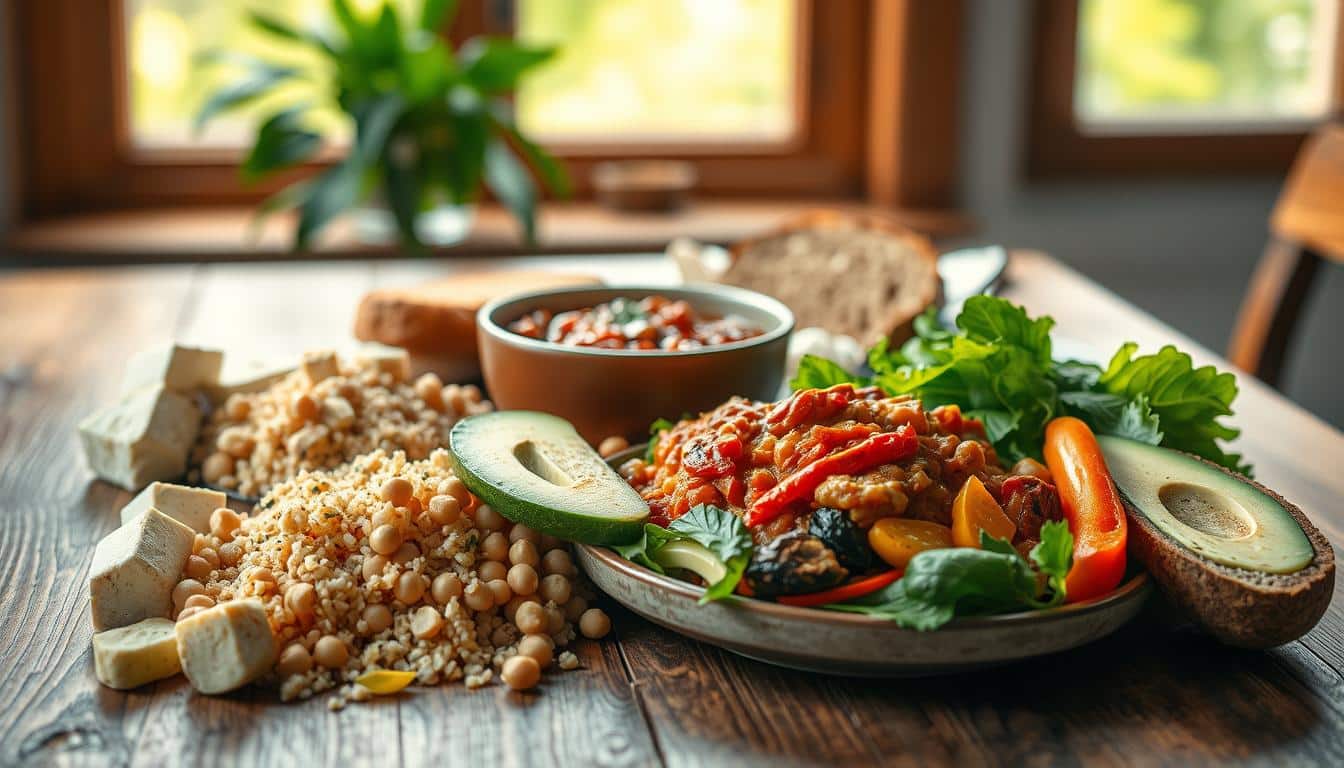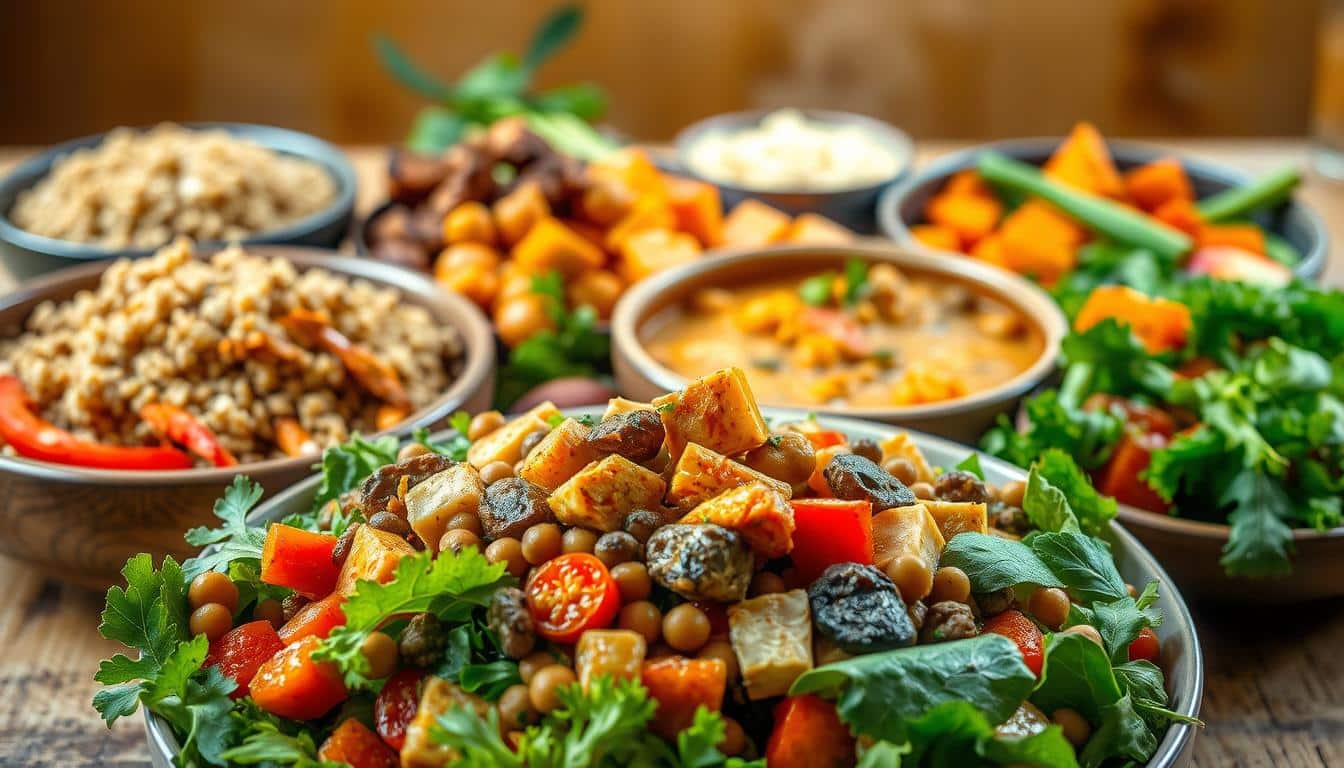Think plant-based lunches leave you hungry by 2 PM? Let’s rewrite that story. What if your midday meal could deliver 15-28 grams of energy-sustaining fuel per serving while tasting incredible?
We’ve cracked the code for satisfying meatless dishes that power through busy days. Forget complicated cooking – these solutions work for real life. You’ll discover how everyday ingredients like chickpeas and lentils become flavor-packed stars.
Each recipe focuses on simplicity without skimping on nutrition. They’re loaded with fiber, vitamins, and essential amino acids to help you stay focused. Better yet? Most take less time than waiting in a drive-thru line.
Tracking your intake becomes effortless with clear protein counts listed for every dish. Whether you’re meal-prepping or need a quick fix, these ideas prove plant-powered eating doesn’t mean sacrificing satisfaction. Ready to transform your lunch routine?
Getting Started with Vegetarian Protein
Building meals around plant-powered fuel might seem tricky at first – until you realize how many options already sit in your pantry. Common ingredients like lentils, chickpeas, and eggs deliver complete proteins when paired smartly. Even cheeses like ricotta or parmesan add quick boosts without complicated prep.

Your body needs nine essential amino acids daily. While animal products contain all nine, plants often lack one or two. But here’s the secret: combining grains with legumes (like rice + beans) creates complete protein profiles. You don’t need to pair them in one meal – spreading different sources across your day works just as well.
Start with familiar favorites. Black bean tacos with a sprinkle of cheese? That’s a protein powerhouse. Scrambled tofu with spinach? Another winner. Track your intake using apps or simple notes to ensure you’re meeting your goals.
Remember, variety matters. Rotate between beans, lentils, and soy products to cover all nutrient needs. With a little planning, you’ll discover how effortless it becomes to fuel your body fully through plant-based choices.
High Protein Vegetarian Lunch: Key Concepts
Ever wonder what turns a simple salad into a powerhouse meal? The answer lies in strategic ingredient pairings that deliver 15-28 grams of fuel per plate. This range keeps energy steady without complex calculations.

Start by aiming for at least 15 grams of plant-powered fuel per portion. Many favorite dishes – like spiced chickpea wraps or quinoa bowls – hit 20+ grams effortlessly. Combine beans with whole grains, or add seeds/nuts to boost incomplete sources.
Variety matters more than perfection. Rotate between lentils, tempeh, and dairy products like Greek yogurt throughout your week. This natural rotation covers all essential amino acids over time.
When shopping, prioritize these staples:
- Legumes (black beans, edamame)
- Whole grains (farro, bulgur)
- Fermented soy (tempeh, miso)
The best meatless options keep you satisfied for 4+ hours. They balance fiber-rich carbs with quality fuel sources. Try our roasted chickpea pitas or lentil-stuffed sweet potatoes – both deliver 22+ grams per serving.
Nutritional Benefits of Protein-Rich Meals
You might think skipping meat means missing key nutrients, but plant-powered plates pack a surprising punch. These dishes deliver complete nutrition while keeping energy levels steady – no afternoon crashes here.
Building Blocks for Better Energy
Every bite does more than fill you up. Combining ingredients like quinoa and black beans creates all nine essential amino acids your body can’t make alone. You’ll also get:
- Fiber that digests slowly – keeps hunger away for hours
- Antioxidants fighting cellular stress
- Iron and zinc for immune support
How They Stack Up Against Classic Lunches
Let’s break down how these dishes compare to typical deli sandwiches or fast-food options:
| Nutrient | Plant-Based Option | Traditional Meal |
|---|---|---|
| Protein per serving | 18-22 grams | 24-28 grams |
| Fiber | 8-12 grams | 2-4 grams |
| Saturated Fat | 1.5g avg | 6g avg |
| Cholesterol | 0mg (vegan) | 80mg avg |
Notice the fiber difference? That’s why people report feeling satisfied longer after meatless options. The lower saturated fat also supports heart health over time.
Prepping these dishes gets easier with tools like effortless slow cooker solutions. You’ll build meals that nourish without complicated steps – just toss ingredients and let time work its magic.
Simple Ingredient Swaps for More Protein
Upgrade your dishes without learning new recipes by changing just one component. Smart exchanges turn familiar meals into nutrient-packed plates while keeping flavors intact. You’ll recognize every technique – we’re simply boosting what already works.
Legumes and Beans vs. Meat
Black beans deliver 15 grams of fuel per cooked cup – matching the protein in 2 ounces of ground beef. They shine in chili, tacos, and soups where meat usually takes center stage. Lentils mimic the texture of ground meat while adding extra fiber and iron.
Try these effortless swaps:
- Pasta: Chickpea noodles add 14g protein per serving vs. 7g in regular
- Yogurt: Greek style doubles the protein with identical creaminess
- Grains: Quinoa offers complete amino acids where white rice falls short
These alternatives often cost less than traditional options. A can of beans costs roughly $1 versus $5/lb for premium ground beef. You’ll notice richer flavors too – legumes absorb spices better than most meats.
Best part? No special skills needed. Use the same pans, same cooking times, and enjoy meals that keep you energized longer. Your taste buds won’t know the difference – but your body will.
Black Bean and Chickpea Recipe Inspirations
Transform your lunchbox with two pantry heroes that deliver big flavor and staying power. These versatile legumes adapt to any cuisine style while packing serious nutritional value – no fancy techniques required.
Quick Black Bean Ideas
Got 15 minutes? Mash canned beans with chili powder for burger patties (16g fuel per serving). Or toss them into a southwest bowl with quinoa and avocado. Both options keep you full for hours without complicated prep.
Chickpea Applications
Roast spiced chickpeas for salad crunch, or blend them into creamy curries (19g per bowl). Their neutral taste makes them perfect for absorbing bold flavors like harissa or coconut milk. Even baked goods get a boost when you swap regular flour for chickpea varieties.
| Recipe Type | Main Ingredients | Fuel Content | Prep Time |
|---|---|---|---|
| Power Bowl | Black beans, brown rice | 18g | 12 min |
| Spiced Patties | Chickpeas, oats | 16g | 20 min |
| Curry | Chickpeas, coconut milk | 19g | 25 min |
Store cooked batches for 4 days – they’ll taste better as flavors meld. Mix and match with different spices to keep meals exciting while hitting your nutrition targets effortlessly.
Tofu: A Versatile Protein Source
Tofu often gets a bad rap, but when handled right, it transforms into your lunchtime MVP. This soy-based superstar adapts to any spice blend or cooking method while delivering 13-25 grams of fuel per serving. Its neutral taste becomes an advantage – think of it as a flavor sponge that soaks up marinades and sauces.
Start with firm or extra-firm varieties for best results. These hold their shape during cooking and develop satisfying textures. Pressing tofu removes excess moisture, helping it crisp up beautifully in pans or on grills.
Grilling and Stir-Frying Techniques
Slice blocks into ¼-inch slabs for even cooking. Toss with olive oil, salt, and pepper – or marinate for 10 minutes to boost flavor. Grill over medium heat for 3 minutes per side until golden. Those char marks add smoky depth to grain bowls or wraps.
Stir-frying unlocks crispy edges with tender centers. Cube tofu and cook in hot oil until browned. Pair with snap peas and teriyaki sauce, or toss into sesame noodles. Both methods take under 15 minutes from pan to plate.
- Store cooked batches in airtight containers (3 days fridge/3 months freezer)
- Double portions for meal prep efficiency
- Experiment with spice rubs or citrus-based marinades
Once you master these basics, you’ll find endless ways to use this flexible ingredient. It’s the quiet workhorse that elevates simple lunches into satisfying meals.
Lentil-Based Lunch Ideas
Lentils aren’t just for soups – they’re your ticket to hearty meals that keep you fueled for hours. These tiny powerhouses deliver 20-28 grams of plant-powered fuel per serving, matching traditional meat dishes bite for bite. Best part? They’re ready faster than you can say “meal prep.”
Chili and Meatball Magic
Six spiced lentil meatballs pack 20 grams of fuel – perfect for stacking on whole-grain rolls or tossing into pasta. Their secret? A blend of oats and walnuts creates a texture even meat lovers crave. Simmer a pot of chili next, and you’ll get 28 grams per bowl with zero soaking required.
Different varieties work better for specific dishes:
| Recipe | Fuel Content | Prep Time | Freeze-Friendly |
|---|---|---|---|
| Spiced Meatballs | 20g | 35 min | Yes |
| Hearty Chili | 28g | 45 min | Yes |
| Moroccan Soup | 21g | 30 min | Yes |
| Walnut Loaf | 24g | 50 min | No |
Red lentils dissolve into creamy textures, while green ones hold shape for salads. Brown varieties strike the perfect middle ground. Cook them in broth instead of water for extra flavor depth.
Batch-cook on Sundays, and you’ve got lunch solved for days. These dishes taste better as spices meld, making them ideal for make-ahead meals. Just reheat and enjoy – no sad desk salads here.
Delicious Vegetarian Salads for Lunch
Who says salads can’t be the star of your lunchbox? Forget limp lettuce and bland dressings – we’re crafting vibrant plates that deliver 16-18 grams of plant-powered fuel while exciting your taste buds. The secret lies in combining crisp textures with hearty ingredients that keep energy levels steady all afternoon.
Power Pairings That Satisfy
Try a kale and edamame mix with lemon-tahini drizzle. The quinoa base provides all nine essential amino acids, while those green soybeans add a satisfying crunch. Prefer something creamy? Mash avocado into black beans for a southwest-inspired bowl that tastes like sunshine on a plate.
Farro salads work beautifully for meal prep. Toss the ancient grain with peppery arugula, roasted artichokes, and crushed pistachios. It gains flavor overnight as the tangy vinaigrette soaks into every bite. You’ll find yourself reaching for seconds – without the usual post-lunch slump.
Three rules for success:
- Mix crunchy elements (nuts, seeds) with soft ones (beans, roasted veggies)
- Use bold dressings like ginger-miso or spicy peanut
- Add fresh herbs for brightness – basil or cilantro work wonders
These combinations prove that salads can be both nourishing and exciting. They’re packed with colorful veggies, but the real magic happens when you layer flavors and textures. Prep components on Sunday, then assemble lunches in minutes throughout your week.
Creative Pasta and Noodle Dishes
Craving comfort food that fuels your day? Your favorite carb-loaded classics get a nutrition upgrade with simple tweaks. Swap regular pasta for versions made from lentils or chickpeas – they cook the same but deliver double the staying power.
Flavor Boosters That Work Hard
Turn basic dishes into power meals with smart additions. Ricotta adds creaminess to tomato sauce while packing 14g of fuel per half-cup. Try lemon-pepper spaghetti with crumbled feta – it hits 21g per plate using ingredients you already know.
Smart Swaps for Lasting Energy
Whole grain options like brown rice noodles pair perfectly with sesame-tahini dressings. These combos provide complete amino acid profiles. Arugula pesto made with cottage cheese and basil gives linguine a fresh twist with 18g per serving.
Store-bought alternatives simplify prep. Chickpea fusilli needs just 8 minutes boiling before tossing with roasted veggies. Leftovers? They’ll keep for 3 days, tasting better as flavors meld. Your weekday meals just got tastier – and way more satisfying.


